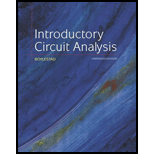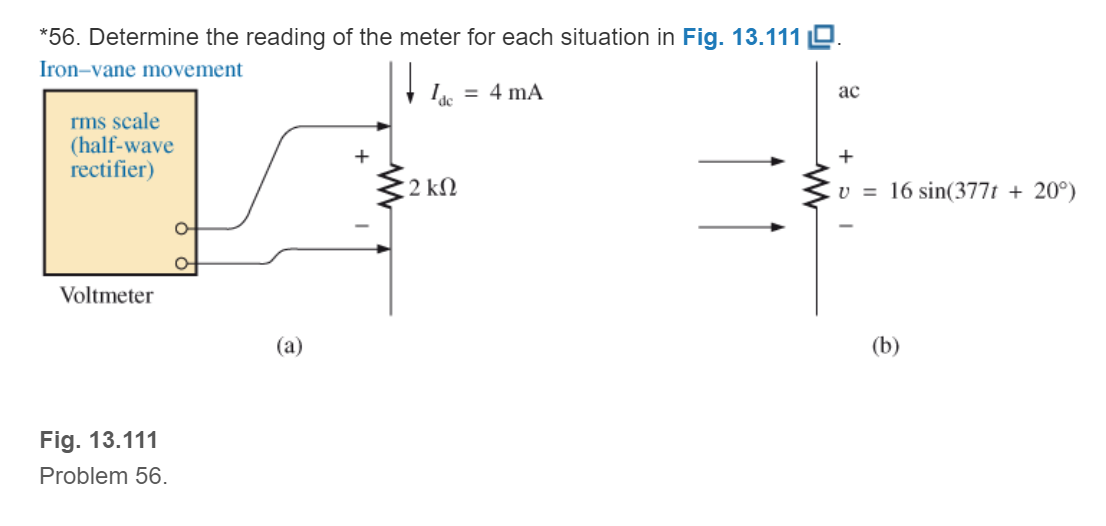
Laboratory Manual for Introductory Circuit Analysis
13th Edition
ISBN: 9780133923780
Author: Robert L. Boylestad, Gabriel Kousourou
Publisher: PEARSON
expand_more
expand_more
format_list_bulleted
Concept explainers
Textbook Question
Chapter 13, Problem 56P
Determine the reading of the meter for each situation in Fig. 13.111.

Fig. 13.11
Expert Solution & Answer
Want to see the full answer?
Check out a sample textbook solution
Students have asked these similar questions
Correct answer given but show full work to get answer no use of AI only handwritten answer
Draw the fabrication layers of a transistor with MS junction (Schottky junction).
Q: Draw the fabrication layers of a transistor with MS junction (Schottky
junction).
Chapter 13 Solutions
Laboratory Manual for Introductory Circuit Analysis
Ch. 13 - For the sinusoidal waveform in Fig. 13.85: a. What...Ch. 13 - For the sinusoidal signal in Fig. 13.86: a. What...Ch. 13 - For the periodic square-wave waveform in Fig....Ch. 13 - For the waveform of Fig. 13.88: a. Does this...Ch. 13 - Find the period of a periodic waveform whose...Ch. 13 - Find the frequency of a repeating waveform whose...Ch. 13 - If a periodic waveform has a frequency of 1 kHz,...Ch. 13 - Find the period of a sinusoidal waveform that...Ch. 13 - What is the frequency of periodic waveform that...Ch. 13 - For the oscilloscope pattern of Fig. 13.89: a....
Ch. 13 - For the waveform of Fig. 13.90: a. What is the...Ch. 13 - Convert the following degrees to radians: a. 40 b....Ch. 13 - Convert the following radians to degrees: /3 1.2...Ch. 13 - Find the angular velocity of a waveform with a...Ch. 13 - Find the angular velocity of a waveform with a...Ch. 13 - Find the frequency and period of sine waves having...Ch. 13 - Given f=60Hz, determine how long it will take the...Ch. 13 - If a sinusoidal waveform passes through an angle...Ch. 13 - Find the amplitude and frequency of the following...Ch. 13 - Sketch 6 sin 754t with the abscissa angle in...Ch. 13 - Sketch 8sin280t with the abscissa angle in...Ch. 13 - If e=300sin157t, how long (in second) does it take...Ch. 13 - Giveni=0.5sindetermine=72.Ch. 13 - Givenv=20determine=1.2.Ch. 13 - Givenv=30103determinetheanglesatwhichuwillbe6mV.Ch. 13 - If v=40Vat=30andt=1ms, determine the mathematical...Ch. 13 - Sketch sin (377t+60) with the abscissa angle in...Ch. 13 - Sketch the following waveforms: 50sin(wt+0)...Ch. 13 - Write the analytical expression for the waveforms...Ch. 13 - Write the analytical expression for the waveform...Ch. 13 - Write the analytical expression for the waveform...Ch. 13 - Write the analytical expression for the waveform...Ch. 13 - Find the phase relationship between the following...Ch. 13 - Find the phase relationship between the following...Ch. 13 - Prob. 35PCh. 13 - Find the phase relationship between the following...Ch. 13 - The sinusoidal voltage v=160sin(21000t+60) is...Ch. 13 - Prob. 38PCh. 13 - For the waveform of Fig. 13.95, find the time when...Ch. 13 - For the oscilloscope display in Fig. 13.97:...Ch. 13 - Find the average value of the periodic waveform in...Ch. 13 - Find the average value of the periodic waveforms...Ch. 13 - Find the average value of the periodic waveform of...Ch. 13 - Find the average value of the periodic waveform of...Ch. 13 - Find the average value of the periodic function of...Ch. 13 - Find the average value of the periodic waveform in...Ch. 13 - For the waveform in Fig. 13.104: Determine the...Ch. 13 - For the waveform in Fig. 13.105: Determine the...Ch. 13 - Find the rms values of the following sinusoidal...Ch. 13 - Write the sinusoidal expressions for voltages and...Ch. 13 - Find the rms value of the periodic waveform in...Ch. 13 - Find the rms value of the periodic waveform in...Ch. 13 - What are the average and rms values of the square...Ch. 13 - For each waveform in Fig. 13.109, determine the...Ch. 13 - For the waveform of Fig. 13.110: Carefully sketch...Ch. 13 - Determine the reading of the meter for each...
Knowledge Booster
Learn more about
Need a deep-dive on the concept behind this application? Look no further. Learn more about this topic, electrical-engineering and related others by exploring similar questions and additional content below.Similar questions
- + C/E, 4 TA b IA + 2V C/E 2 +1 - C + V3 - C/EU - ча - V4 + e + /E3 V2 12V a (a) Find currents L, L2 and is (b) Find Voltages V, V2, V3 and V4 - 2A CIEG For each circuit element and the two sources state whether they are ABSORBING SUPPLYING pores and how much poner 13 absorbed or supplied. +arrow_forwardPlease solve part a, b and c Also, find the impulse response g(t) for the systemarrow_forwardConsider the lateral dynamics of a vectored thrust aircraft as described in Example 3.12. Show that the dynamics can be described using the following block diagram: Ꮎ r ալ -mg Σ J82 ע 1 X ms² + cs Use this block diagram to compute the transfer functions from u₁ to 0 and x and show that they satisfy Нои r Js² - mgr Js²' Hau₁ Js2 (ms2+cs)arrow_forward
- Consider the system dx ax+u. dt Compute the exponential response of the system and use this to derive the transfer function from u to x. Show that when s = a, a pole of the transfer function, the response to the exponential input u(t) = est is x(t) = eat x(0) + teat. For solving the system with u = eat eat you can't use the transfer function because the denominator is zero. Try using the convolution integral solution with initial conditions set as x(t) = eat x (0) + fo g(t − T)u(T)dT - g(t) is the impulse response of the system.arrow_forwarddny dn-1y dn-1u dn-24 +a1 + + Any = bi +b₂- + +bnu. dtn dtn-1 dtn-1 dtn-2 a) Let be a root of the characteristic equation 1 sn+a1sn- + +an = : 0. Show that if u(t) = 0, the differential equation has the solution y(t) = e\t. b) Let к be a zero of the polynomial b(s) = b₁s-1+b2sn−2+ Show that if the input is u(t) equation that is identically zero. = .. +bn. ekt, then there is a solution to the differentialarrow_forwarddny dn-1y dn-1u dn-24 +a1 + + Any = bi +b₂- + +bnu. dtn dtn-1 dtn-1 dtn-2 a) Let be a root of the characteristic equation 1 sn+a1sn- + +an = : 0. Show that if u(t) = 0, the differential equation has the solution y(t) = e\t. b) Let к be a zero of the polynomial b(s) = b₁s-1+b2sn−2+ Show that if the input is u(t) equation that is identically zero. = .. +bn. ekt, then there is a solution to the differentialarrow_forward
- For step a), use equations (2) to find the equation for the input impedance equations (2) are V1 = jwL1I1 + jwMI2 and V2 = jwMI1 + jwL2I2 equation for the input impedance: Z1 = V1/I1 = jwL1 + (wM)2/(jwL2 + ZL)arrow_forwardL (a) Find currents i, and b₂ 2 2 (b) Find the dependent source voltage given as Find voltages V, and (c) V₂ 5i2 (d) For each circuit element in the circuit and the two Sources, state whether they are ABSORBING OF SUPPYING Power and how much power is absorbed or Supplied. + V - 5A +lov- C/E₂ + C/E4 Vz い 5+2 + 1A C/E 5V + シュ 2A + 10Varrow_forward4) A circuit is given as shown. (a) Find currents i, and i2. (b) Find the dependent source voltage given as 5i2 (c) Find voltages V, and V₂ 2 (d) For each circuit element in the circuit and the two Sources, State whether they are ABSORBING, OF SUPPLYING POWER and how much power is absorbed or supplied. + 10V - + 4 CIES C/E + V L₁ 4 1A Y T5A GE -5V + CIES iz 2A 2 52 2 +arrow_forward
- Determine the eigenvalues and eigenvectors of using A = ( 1 -3 3 3 -5 3 6-64 Gauss eliminationarrow_forward5) A circuit is given as shown (a) Find currents i₁, L2 and is . (6) Find voltages V, V2, V3 and Vy (c) For each circuit element in the circuit and the two sources, state whether they are ABSORBING SUPPLYING POWER and how much power is absorbed or supplied. + V₁ CIE, 1A +2V- C/E AS 1A + - 4A Vy+ CES CIES 2A4 + IOV +- + + V2 1 434 12V GVarrow_forwardDetermine the eigenvalues and eigenvectors of using Gauss A = -3 322 20 132 -3° 10 -2 4 eliminationarrow_forward
arrow_back_ios
SEE MORE QUESTIONS
arrow_forward_ios
Recommended textbooks for you
 Introductory Circuit Analysis (13th Edition)Electrical EngineeringISBN:9780133923605Author:Robert L. BoylestadPublisher:PEARSON
Introductory Circuit Analysis (13th Edition)Electrical EngineeringISBN:9780133923605Author:Robert L. BoylestadPublisher:PEARSON Delmar's Standard Textbook Of ElectricityElectrical EngineeringISBN:9781337900348Author:Stephen L. HermanPublisher:Cengage Learning
Delmar's Standard Textbook Of ElectricityElectrical EngineeringISBN:9781337900348Author:Stephen L. HermanPublisher:Cengage Learning Programmable Logic ControllersElectrical EngineeringISBN:9780073373843Author:Frank D. PetruzellaPublisher:McGraw-Hill Education
Programmable Logic ControllersElectrical EngineeringISBN:9780073373843Author:Frank D. PetruzellaPublisher:McGraw-Hill Education Fundamentals of Electric CircuitsElectrical EngineeringISBN:9780078028229Author:Charles K Alexander, Matthew SadikuPublisher:McGraw-Hill Education
Fundamentals of Electric CircuitsElectrical EngineeringISBN:9780078028229Author:Charles K Alexander, Matthew SadikuPublisher:McGraw-Hill Education Electric Circuits. (11th Edition)Electrical EngineeringISBN:9780134746968Author:James W. Nilsson, Susan RiedelPublisher:PEARSON
Electric Circuits. (11th Edition)Electrical EngineeringISBN:9780134746968Author:James W. Nilsson, Susan RiedelPublisher:PEARSON Engineering ElectromagneticsElectrical EngineeringISBN:9780078028151Author:Hayt, William H. (william Hart), Jr, BUCK, John A.Publisher:Mcgraw-hill Education,
Engineering ElectromagneticsElectrical EngineeringISBN:9780078028151Author:Hayt, William H. (william Hart), Jr, BUCK, John A.Publisher:Mcgraw-hill Education,

Introductory Circuit Analysis (13th Edition)
Electrical Engineering
ISBN:9780133923605
Author:Robert L. Boylestad
Publisher:PEARSON

Delmar's Standard Textbook Of Electricity
Electrical Engineering
ISBN:9781337900348
Author:Stephen L. Herman
Publisher:Cengage Learning

Programmable Logic Controllers
Electrical Engineering
ISBN:9780073373843
Author:Frank D. Petruzella
Publisher:McGraw-Hill Education

Fundamentals of Electric Circuits
Electrical Engineering
ISBN:9780078028229
Author:Charles K Alexander, Matthew Sadiku
Publisher:McGraw-Hill Education

Electric Circuits. (11th Edition)
Electrical Engineering
ISBN:9780134746968
Author:James W. Nilsson, Susan Riedel
Publisher:PEARSON

Engineering Electromagnetics
Electrical Engineering
ISBN:9780078028151
Author:Hayt, William H. (william Hart), Jr, BUCK, John A.
Publisher:Mcgraw-hill Education,
Electrical Measuring Instruments - Testing Equipment Electrical - Types of Electrical Meters; Author: Learning Engineering;https://www.youtube.com/watch?v=gkeJzRrwe5k;License: Standard YouTube License, CC-BY
01 - Instantaneous Power in AC Circuit Analysis (Electrical Engineering); Author: Math and Science;https://www.youtube.com/watch?v=If25y4Nhvw4;License: Standard YouTube License, CC-BY